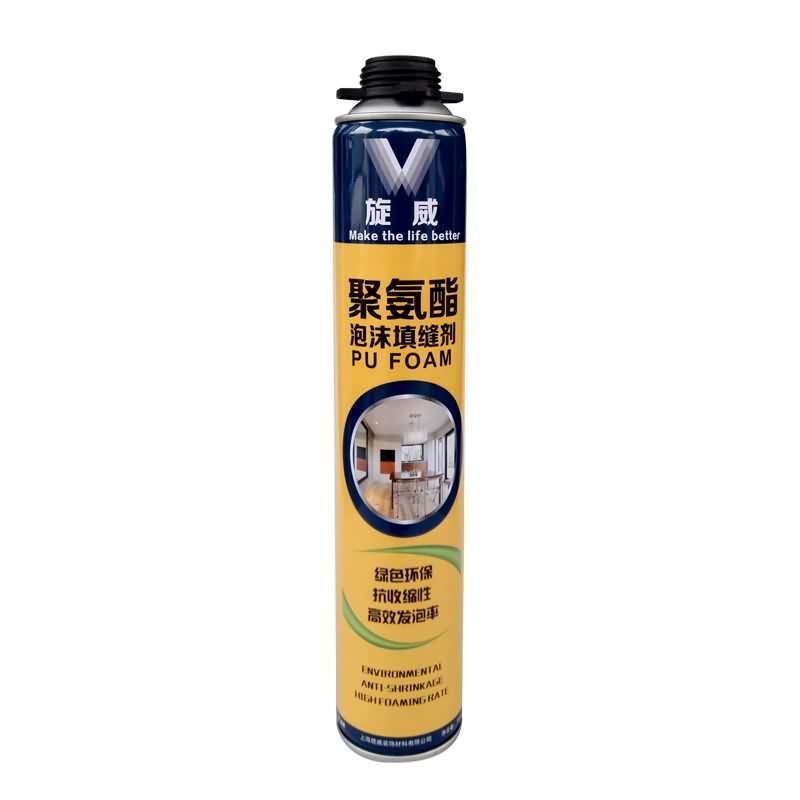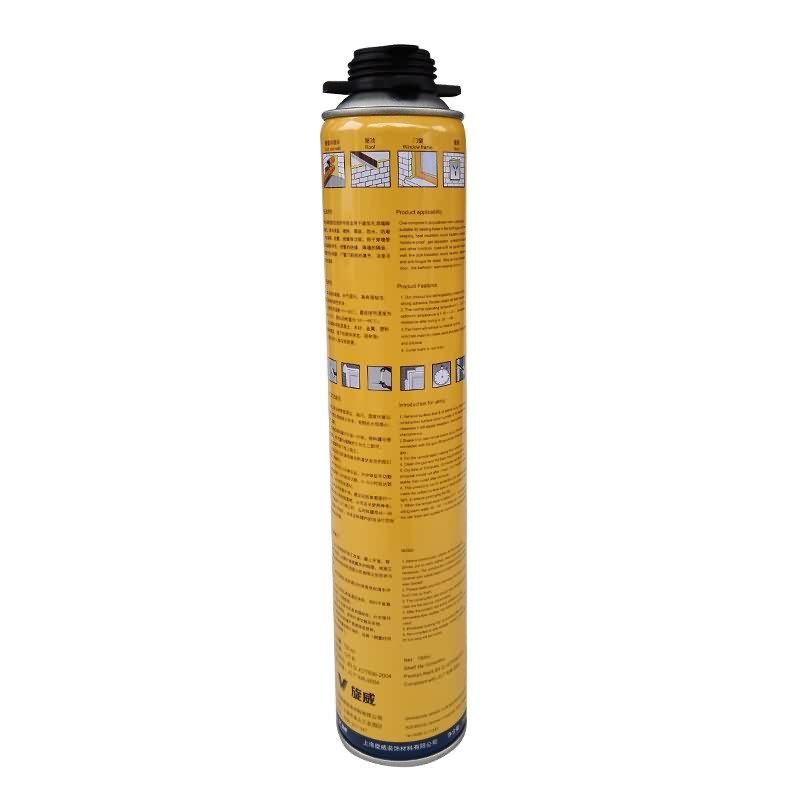Factory Price For Siway PU FOAM to Colombia Manufacturers
Short Description:
Description This product is the expansion, moisture curing, has the strong cohesiveness, elastic foam obturator structure; Save work to save time, reduce waste; High bond strength; Bubble can stick in the concrete, wood, metal, plastic, such as base material surface, but not including teflon, silicon resins; Key Features 1. Noise silencing effect 2. Strong bonding strength 3. Water & weatherproof 4. Primerless adhesion to most building materials Basic Application 1.Doors and Windows a...
In order to best meet client's needs, all of our operations are strictly performed in line with our motto " High Quality, Competitive Price, Fast Service " for Factory Price For Siway PU FOAM to Colombia Manufacturers, We are sincerely welcome good friends from numerous circles at dwelling and abroad come to cooperate!
Description
This product is the expansion, moisture curing, has the strong cohesiveness, elastic foam obturator structure; Save work to save time, reduce waste; High bond strength;
Bubble can stick in the concrete, wood, metal, plastic, such as base material surface, but not including teflon, silicon resins;
Key Features
1. Noise silencing effect
2. Strong bonding strength
3. Water & weatherproof
4. Primerless adhesion to most building materials
Basic Application
1.Doors and Windows and wall body between the gap filling sealing, fixed bond
2.Language lab, studio, etc when decorating, gap to fill
Technical data sheet
|
Project |
Value |
||
|
Density, Kg/m³,Not less |
10 |
||
|
Thermal conductivity,35℃,W/(m·K) no more than |
0.050 |
||
|
Dimensional stability(23±2)℃,48,h no more than |
5 |
||
|
Operating temperature |
-10~+35℃ |
||
|
Optimum operating temperature |
+18~+25℃ |
||
|
Temperature range(After curing) |
-35~+80℃ |
||
|
Tensile bond strength kPa Not less |
Aluminum plate |
Standard condition,7d |
80 |
|
Immersion,7d |
60 |
||
|
PVC plate |
Standard condition,7d |
80 |
|
|
Immersion,7d |
60 |
||
|
Cement Plate |
Standard condition,7d |
60 |
|
|
Shear strength,kpa,Not less |
80 |
||
|
Foam expansion ratio,Not less |
Standard value-10 |
||
Certification
JC 936-2004
Color
White
Package
750ml in Bottle * 12 per box
Shelf life
12 months
Note
If you want the TDS or MSDS or other details, please contact with our sales person.
https://www.sincosilicone.com/
Email: info@sincosilicone.com
(1) Direct factory/manufacturer
(2) Experienced Technical Staffs
(3) Strong Production Capacity
(4) Timely delivery, guaranteed quality and good after-sales service to customers
(5) Management Certification: ISO9001:2000
Turning the 3d printer to change the filament is kind of a pain, so I made a way to spin it, and store filament and tools!
Subscribe to my channel: https://bit.ly/1k8msFr
MORE PROJECTS, POSTS AND EVENTS
https://www.iliketomakestuff.com
GET MORE INFO ON THIS PROJECT:
https://www.iliketomakestuff.com/make-spinning-3d-printer-workstation
HERE’S WHAT YOU’LL NEED:
https://amzn.to/1NCVmAb – SawStop cabinet saw
https://amzn.to/1GMrfGL – Dewalt 20v drill driver combo
https://amzn.to/1HdQuwD – Grizzly G0555LANV Bandsaw
https://amzn.to/1GyGjbg – Grizzly Drill Press
https://amzn.to/1ntzLSF – Silicone spray
https://amzn.to/1ntzEGI – 12″ lazy susan bearing
https://amzn.to/1WnkyhQ – Pancake compressor/ brad nailer combo
https://amzn.to/1LZGfxW – Ultimaker 2 Extended 3D printer
Want to support ILTMS? Get early viewing, exclusive content and more…
https://www.iliketomakestuff.com/patreon
BUY A SHIRT, STICKER, PENCILS and MORE!!
https://www.iliketomakestuff.com/store
FOLLOW:
https://twitter.com/iliketomakestuf
https://instagram.com/iliketomakestuff
https://facebook.com/iltms
I used scrap plywood for this project, so it was a combination of 1/2″, 3/4″ plywood and MDF.
I cut down three pieces to 14 3/4″ squares, as this was a little larger than the footprint of my printer.
I cut a couple of strips for the side panels. These were a little taller than the diameter of a filament roll.
On one of these pieces, I centered a filament roll and traced the inner circle.
I made a mark at the far outside of the circle, and drew in a place for a 1/2″ dowel hole.
I lined the two pieces up and drilled a 1/2″ hole through both.
I sat the side pieces in place on the base and traced the edge. This shows me the safe area to drill holes. I did the same for the other square piece.
On both pieces, I drilled countersunk holes in the safe area.
The side pieces got glue on one side before being screwed to the bottom square.
I mistakenly glued the top at this point too, but don’t do that. Just screw it on.
I tested the spacing with a roll of filament hanging on the dowel rod.
I cut another scrap that fit within the open side of the box, to act as a drawer front.
Two pieces were cut down to act as the sides of the drawer. Their depth was about the depth of the box minus the diameter of the filament roll.
I sat the side panel on the side of the box and pivoted it off the bottom front edge. I made a mark on the side panel where I wanted it to hit the box top.
Using a straight edge, I drew a line from my mark to the opposite top corner.
With both side pieces taped together, I cut along my line on the bandsaw.
I trimmed a piece, for the back, down to the same height as the back side of the side panels.
Since I was out of plywood scrap, I cut the drawer bottom from MDF.
I applied glue to all of the surfaces that would touch.
I folded the pieces up into place and used some brad nails to hold everything in place while the glue dried.
Using a spacer (scrap), I marked the location for two hinges on the front, bottom edge.
I predrilled holes for the hinges, and screwed them in.
I held the drawer in place, upside down, to align and screw in the hinges.
I flipped the drawer up into place. It was tighter than I wanted, but fit correctly.
I sanded down the rough edges and the sides of the drawer where it touched the outer box.
I applied some paste wax to the areas that touched which made the drawer move very smoothly!
I 3d printed a quick knob (but any knob would work fine).
Using a very small bit, I drilled a hole right in the center of the drawer front.
I ran a screw in from the back side directly into the back of the knob to hold it in place.
I sat the printer in place, centered on the top of the box, and nailed on some small strips along the side of it, keeping them very snug to the printer.
On the base panel, I measured a lazy susan bearing, and found the difference in the base’s width and the bearings diameter. I split the difference and marked in that distance from each edge.
Having these four marks allowed me to easily center the bearing on the base.
The two parts of the bearing got lined up so you could see a hole all of the way through. I marked these (4) holes onto the base.
Each hole got drilled, with a countersink bit.
I centered the bearing the same way on the bottom of the cabinet, but screwed it in place using the four inner holes.
The bearing comes un-lubricated, so I sprayed in a little silicone spray and worked it into the bearing.
Laying the base on top of the bearing, I aligned the holes using a drill bit and my ice pick.
I drove in screws, through the base, into the bearing holes. These are small holes made to be grabbed by sheet metal screws.
I flipped the whole thing over and took it for a spin (pun intended).
I was able to fit four rolls of filament on the 7/16″ dowel.
I added all of the 3d printing tools to the drawer and put it in place in my office.
Now I can easily spin the machine to swap filaments! Second channel: bit.ly/iltms-2





